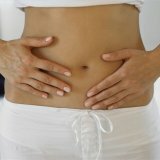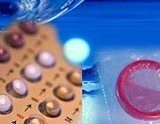Female diseases: inflammation of the appendages

Causes of inflammation.
Disease appears ascending way from the uterine cavity, descending - from the peritoneum. The lymphogenous pathway is the penetration of infection from the sigmoid colon and appendix. Hematogenous pathway - with distant infections in the body. The causative agent penetrates from the uterus into the fallopian tubes and forms an inflammation of their mucosa. Often caused by inflammation of the muscular membranes and abdominal cover. Inflammation flows into the swelling that closes the lumen of the tube. The malignant fluid accumulates and a tumor of the tube with a large presence of pus is formed.
Inflammation of the uterine tube alone is rare. Ovaries are usually affected: there is swelling and hyperemia develops. With complicated inflammatory processes, there is an ovarian abscess. As a result of lesions of the appendages, tissue destruction occurs, an enlarged formation with purulent contents is formed. In the case of ruptures of this formation, the inflammation is transferred to the peritoneum, resulting in the appearance of pelveoperitonitis. Inflammation of the appendages often enters the chronic form, forming a recurring course of the disease.
Symptoms.
Symptoms depend on both the stage and the severity of the inflammation. The general condition of the patient and the characteristics of his organism play an important role, as well as what kind of microbes were the causative agents of the disease.
Similar kind of female diseases are divided into symptoms into two types: general and local. Local symptoms include various damage to the appendages and the result of their action. General symptoms include the reaction of the body to the pathological process. Local symptoms: leucorrhoea, severe pain, bleeding during menstruation, not pregnancy. The pain in the inflammation of the appendages is constant, aching, often increases with a break of purulent contents - then the pain becomes simply unbearable. The pains are concentrated in the iliac regions, "giving" at the same time to the sacrum. Before the rupture of purulent contents in the intestine, painful attacks occur, pressure on the rectum or on the bladder increases.
Pains in chronic form are dull and bother constantly. Especially pain increases during menstruation, with heavy loads, during sexual intercourse, during examination at the gynecologist. Allocations in this case are different: mucous, purulent, serous. With the accumulation of purulent contents in the uterus, there is a possibility of a sudden flow of a large number of purulent masses directly from the vagina.
With persistent discharge, the patient has itching, excruciates a sensation of irritation of the genital organs, and a repeated vulvitis develops.
The menstrual cycle is broken with characteristic bleeding - cyclic or acyclic. Menstruation is usually unattractive, but much longer. The causes of menstrual cycle disorders are found in inflammation and damage to the ovary parenchyma and in the accompanying endometrial injury. With chronic inflammation of the appendages, menorrhagia is often observed.
The inability to become pregnant is due to the transition to a chronic stage of the disease. Usually as a result of the adhesive process, the obstruction of the tubes in the mucosa develops. The reason can be in the adhesive process inside the peritoneum. After the transferred inflammation there is a probability of disturbance of a hormonal background of ovaries and as a result of it - development of barreness.
Common symptoms of appendage disease are: fever, weakness, headache, chills, nausea, vomiting, dry mouth.
During the examination, there are tachycardia, pain and bloating, dryness of the tongue. A blood test shows an increase in ESR, leukocytosis, a change in blood composition.
Symptoms of acute inflammation of the appendages are revealed by growing pains of noisy character. Patients mistakenly accept them for the consequences of menstruation, abortion or a planned gynecological examination. However, then begins to rapidly deteriorate state of health, excruciate severe headaches, body temperature increases. The body begins to react to varying degrees. With purulent inflammation, the symptoms are more pronounced.
Treatment.
Treatment with traditional methods is primarily to eliminate the inflammatory processes of the fallopian tubes and ovaries. It is necessary to restore the normal work of the appendages, while preserving the health of women. For this, a whole therapeutic complex is used: sulfonamides, antibiotics, desensitizing agents, vitamins, enzymes, biostimulants. Also, ice is applied to the bottom of the abdomen, physiotherapy, and infusion therapy.
In the chronic form of adnexitis treatment is prescribed according to indications. This can be a physiotherapy treatment using ultrasound or current, as well as spa treatment and mud baths.
In case of complications of the disease, surgical intervention is required. The acute stage of inflammation of the appendages involves the risk of breaking an abscess that no longer responds to treatment, as well as the risk of a sharp increase in the tube and ovary with purulent contents.
If necessary, surgical intervention takes into account the age of the patient, the history and desire to preserve fertility is studied. It is necessary to remove all affected tissues. In surgical treatment, abdominal salpingo-oophorectomy and pelvic drainage are usually performed.
Traditional methods of treatment.
Infusion from a round-leafed wintergreen. Take 2 teaspoons of leaves of the wintergreen and grow steamed in a glass of boiling water. Infused for 2 hours and filtered. Take infusion should be 0.25 cup three times a day.
Collection of herbs for syringing. Take five parts of the herb mountaineer's bird, one piece of chamomile and three parts of the leaves of the nettle. Mixture of ingredients( 2 tablespoons), soak in a liter of boiling water and insist for an hour. Use this syringing should be done twice a day.
Broth from the goose fir grass. Two tablespoons of herbs soak in a half liter of boiling water and insist an hour. Decoction take half a cup four times a day on an empty stomach.
Decoction of juniper berries. 15 gr. The berries are insisted for four hours in a glass of water. Decoction drink one tablespoon three times a day.



